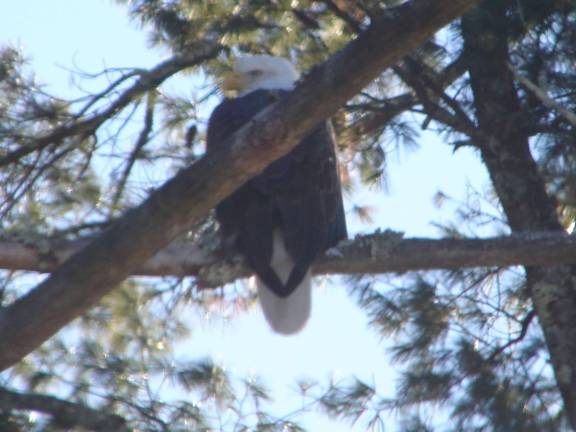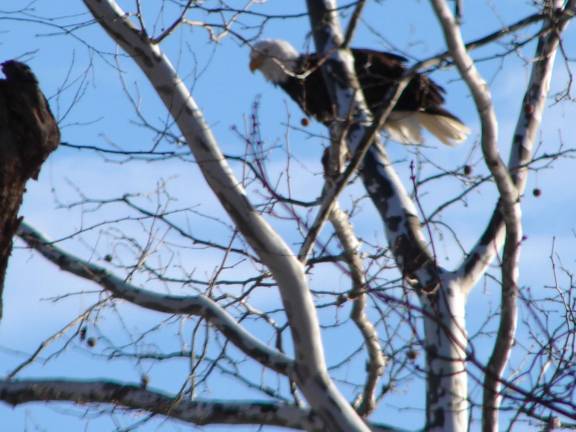Of dark-eyed juncos and ruby-crowned kinglets


The second 2017-18 Dr. S. Marie Kuhnen Memorial Field Trip, "Search for Eagles," took place in the Delaware Valley on Jan. 7. The temperature at the start was negative 6 degrees and at the finish 10 degrees. It was a cold clear day that began with watching feeder birds including hairy and downy woodpeckers, dark-eyed junco, blue jays, tree sparrow, and red-shouldered hawk among others. The six participants logged 134 miles in the Delaware Water Gap National Recreation Area and Upper Delaware Scenic River from PEEC to the Bushkill Access and the trip’s conclusion at the headwaters of the Lackawaxen River.
Jack Padalino, president emeritus of the Pocono Environmental Education Center (PEEC) and the Brandwein Institute, a partner with the National Park Service, led the search that included seeing 36 species of birds including 24 bald eagles (be), 18 red-tailed hawks, 2 red-shouldered hawks, and 4 common ravens.
First raptor foundThe first raptor of the day was a red-tailed hawk perched west of route 209 near the turn from Route 209 to PEEC at Briscoe Mountain Road. The Bushkill Access, closed for the winter, in the Delaware Water Gap National Recreation Area had 4 pileated woodpeckers on the ridge in a dead White Pine. We watched a mixed flock of blackbirds, red-wings and common grackles along with starlings feeding in white pine cones high above us near the ridge top.
Our first bald eagle was an adult perched west of Route 209 a mile south from the Eshback Access. There is probably a nest proximal to where the bald eagle was perched. By the time we reached Chestnut Ridge Road we had seen 3 Red-tailed Hawks. We added 2 red-tails at the Dingmans Campground, 2 red-tails on the way to the Dingmans Ferry Bridge, and one more red-tail at the bridge.
No eagles at the Dingmans Ferry Access, also closed for the winter; however, a flock of dark-eyed juncos greeted us as we watched the feeders at the toll booth. The juncos were the most numerous birds on this search. There seemed to be flocks of juncos everywhere.
Although I have been seeing bald eagles this week at the mile marker 17 nest, none were evident today. Two more bald eagles were seen on the way to Milford.
No eagles were present at the Metz Road nest, nor at Milford Beach where a red-tail greeted us.
At the Callahan House, headquarters of the Brandwein Institute we watched feeder birds and added northern cardinal, red-bellied woodpecker, and song sparrow.
While we were enjoying the vocalization of a ruby-crowned kinglet along the river road we spotted an adult bald eagle perched across from us near some open water on the Jersey side.
North of Cummings Road an adult bald eagle was perched on the ridge. This location is near where in past there was an active nest opposite the Kittatinny Camp Ground above the westbound lane along Interstate 80. The nest is no longer there.
We continued to the Best Western, no eagles. At the River View Restaurant near where PA, NJ, and NY converge, no eagles; however, a local resident told us about two nearby bald eagle nests.
We enjoyed a rest stop at the Pennsylvania Welcome Center where we viewed a 701 pound Trophy Black Bear. A red-tails was perched atop a roadside White Pine in Matamoras.
Heard but not seenThe Eddy Farm Resort overlook was quiet, no new species added.
By 11:30 we were at the Hawks Nest historical marker. Great vista with an immature bald eagle soaring in the distance. An adult bald eagle flew by us above the ridge. We heard “kak-kak-kak, and Kleek-kik-kik-ik-ik,” bald eagle vocalizations below us. We searched but could not locate the eagle. Mark that as a heard bird.
At the Pond Eddy nest sight, a White Pine on the PA side of the river, three adult bald eagles were seen. The first way off in the distance, the second flew above us and headed for the cliffs, and the third from the left to a perch on the cliff.
We continued to the Mongaup Falls Observation Blind. Just before we crossed the bridge approaching the Observation Blind we spotted an adult bald eagle perched on the left above the road. I was able to capture an image of it to include with this report. We entered the parking area and were treated to an adult bald eagle fly by. We entered the blind, chatted with the Eagle Institute volunteer observers and saw 4 additional bald eagles.
There were four eagles along Plank Road, 2 perched adults and 2 juveniles standing on the ice. Along Plank Road away from Rio Reservoir there was a Common Raven in a road side tree top. Further along the road near the Deerpark border we spotted 2 Common Ravens on the same branch. One took flight and farther up the branch an adult bald eagle was perched.
No eagles at the Rio Reservoir Dam. We returned to he Delaware and traveled upriver.
One adult bald eagle was perched above and next to the road one-half mile from Pond Eddy.
Rock pigeons in ShoholaFrom Barryville we watched an adult bald eagle that was perched atop a dead tree in Shohola. As we were watching a red-tailed hawk scatter about 100 perched rock pigeons the bald eagle took flight downriver. We watch her fly over the Shohola bridge, circle above, then plunge to the open water. For the next ten minutes we watched her pursue a hen Common Merganser who consistently dove as she approached. The bald eagle occasionally rested on the ice, then again took up the pursuit. She was not successful while we watched.
On the Pennsylvania side proximal to the Roebling Bridge is the National Park Service Visitor Center where brochures, newsletters, and information about eagles is made available to visitors.
At the confluence of the Lackawaxen and Delaware rivers is the Zane Gray the parking area and boat launch where trained Eagle Institute volunteers monitor eagle activity.
By the time we had reached the Lackawaxen we had seen 20 Bald Eagles. The river, loaded with ice, was the highest level I had ever seen. The power company probably released water to generate electricity from the dam upstream. As we were about to cross the Lackawaxen and head upstream we spotted an adult bald eagle high on the ridge. We put a spotting scope on the bald eagle and all were able to get great look at it. While scoping the bald eagle we heard the now familiar “kak-kak-kak, and Kleek-kik-kik-ik-ik,” from another bald eagle. While we were crossing the bridge we looked upstream and saw the perched noisy BE. Traveling upstream along the Lackawaxen we saw two additional adult balds. We concluded our field trip at 3:30 p.m.